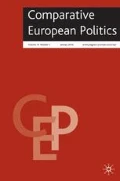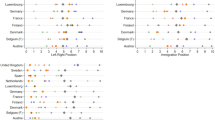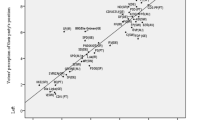Abstract
Building from the work of Nagel and Wlezien (2010) in the United Kingdom, I theorize that liberal parties gain votes from conservative parties across 26 established democracies when conservative parties move to the right, and from social democratic parties when those parties move to the left, as judged by the right-left scale provided by the Comparative Manifesto Project. I also hypothesize that liberal strength at election (t−1) pushes conservative and social democratic parties farther towards the extremes of the left-right spectrum. The models tested herein demonstrate that this in fact does happen cross-nationally, although the effect is considerably weaker than the relationship Nagel and Wlezien identified in the United Kingdom.
Similar content being viewed by others
Notes
The Liberals competed alone until the 1983 general election, when they formed a pact with the Social Democratic party (SDP), a splinter from the right wing of the Labour Party. This coalition, known as the Alliance, continued until 1988, when the two parties merged to form the Liberal Democrats. This work uses the terms ‘Liberals’ or ‘Liberals/Liberal Democrats’ to account for all iterations of the party since 1945.
Meguid (2005) defines niche parties as mostly belonging to the Green or extreme right party families. In this article, the latter family is designated ‘right populist.’
In parts of northern Scotland, where the Liberal Democrats have traditionally maintained a stronghold, their main opponent has become the Scottish National Party (SNP). A cursory glance at the election results from the 2011 Scottish Parliament polls shows a vertiginous decline in Liberal vote shares, which is almost identical in size to the SNP’s gains. Labour and the Conservatives saw relatively modest declines.
Generally associated with Keynesian demand management and a mixed economy, the post-war consensus in Britain was sometimes referred to as ‘Butskellism.’ The term is a portmanteau of Butler, referring to Conservative Party chancellor R.A.B. Butler, and Gaitskell, referring to Hugh Gaitskell, the Labour leader from 1955 to 1963. The two were both centrist politicians with fairly similar policies.
Nagel and Wlezien, as well as Adams and Merrill, draw from Downs (1957), who postulated the median voter theorem.
Or, at the very least, voters seem to expect them to moderate their policies because of coalition pressures. Ezrow (2008) finds little correlation between electoral system type and the extremism of party manifestos, and that proportional systems may encourage greater moderation in party manifestos (480). However, this does not necessarily mean that PR systems adhere to the median voter theory dynamic, as the voters would still be correct in assuming that parties would have to compromise in coalition.
The Swedish general election of 1944, the only pre-1945 election included in the CMP, is also included in the set.
One could argue that the Republicans include non-liberal strands, including a very large pool of religious voters. However, in terms of the party’s conception of the American constitutional order and economic policy, it could be described as ‘classical liberal’ in the broader European sense.
Australia uses STV for Senate elections, but these are not counted by the CMP. France used PR during the Fourth Republic (1946–1958), and again briefly for the 1986 legislative elections.
References
Adams, J.F. and Merrill, III. S. (2006) Why small, centrist third parties motivate policy divergence by major parties. American Political Science Review 100(3): 403–17.
Bara, J., Budge, I., Klingemann, H.-D., Tanenbaum, E. and Volkens, A. (2001) Mapping Policy Preferences: Estimates for Parties, Electors and Governments. 1945–1998. Oxford: Oxford University Press.
Bara, J., Budge, I., Klingemann, H.-D., McDonald, M. and Volkens, A. (2006) Mapping Policy Preferences Volume II: The OECD and Eastern Europe. 1990–2002. Oxford: Oxford University Press.
Bogdanor, V. (1983) Liberal Party Politics. Oxford: Oxford University Press.
Budge, I. and McDonald, M. (2005) Elections, Parties, Democracy: Conferring the Median Mandate. Oxford: Oxford University Press.
Curtice, J. (1996) Who votes for the centre now? In: D. McIver (ed.) The Liberal Democrats. London: Prentice Hall.
Downs, A. (1957) The Economic Theory of Democracy. New York: Harper and Row.
Dutton, D. (2004) A History of the Liberal Party in the Twentieth Century. Basingstoke: Palgrave Macmillan.
European Commission. (1974–2013) Eurobarometer. http://ec.europa.eu/public_opinion/archives/eb_arch_en.htm.
Ezrow, L. (2008) Parties’ policy programmes and the dog that didn’t bark: No evidence that proportional systems promote extreme party positioning. British Journal of Political Science 38: 479–97.
Foley, M. (1991) American Political Ideas. Manchester: Manchester University Press.
Gallagher, M. (1991) Proportionality, Disproportionality and Electoral Systems. Electoral Studies 10: 33–51.
Gallagher, M. (2011) Election indices, http://www.tcd.ie/Political_Science/staff/michael_gallagher/ElSystems/Docts/ElectionIndices.pdf.
Hartz, L. (1955) The Liberal Tradition in America. New York: Harcourt Brace Jovanovich.
Hazan, R. (1997) Centre Parties: Polarization and Competition in European Parliamentary Democracies. London: Pinter.
International IDEA. Voter Turnout Website, http://www.idea.int/vt/index.cfm.
King, G. (1997) A Solution to the Ecological Inference Problem: Reconstructing Individual Behavior from Aggregate Data. Princeton, NJ: Princeton University Press.
Kirchner, E.J. (ed.) (1988) In: Liberal Parties in Western Europe. Cambridge: Cambridge University Press.
Klingemann, H.-D., Volkens, A., Bara, J., Budge, I. and McDonald, M. (2006) Mapping Policy Preferences II. Estimates for Parties, Electors, and Governments in Eastern Europe, the European Union and the OECD. 1990–2003. Oxford: Oxford University Press.
Labour Party of the United Kingdom (1997) New Labour: Because Britain Deserves Better (Labour Party Manifesto 1997). In: Dale, I. (ed.) Labour Party General Election Manifestos, 1900–1997. Vol. 2. London: Routledge, 2000 pp. 343–348.
Macdonald, S. and Rabinowitz, G. (1989) A directional theory of issue voting. American Political Science Review 83(1): 93–121.
Meguid, B. (2005) Competition between unequals: The role of mainstream party strategy in niche party success. American Political Science Review 99(3): 347–358.
Nagel, J. (1998) Social choice in a pluralitarian democracy: The politics of market liberalization in New Zealand. British Journal of Political Science 28(2): 223–267.
Nagel, J.H. and Wlezien, C. (2010) Centre-party strength and major-party divergence in Britain, 1945–2005. British Journal of Political Science 40(2): 279–304.
Narud, H.M. (1996) Electoral competition and coalition bargaining in multiparty systems. Journal of Theoretical Politics 1996(8): 499–525.
Quinn, T. (2012) From two-partism to alternating predominance: The changing UK party system, 1950–2010. Political Studies 61(2): 378–400.
Russell, A. and Fieldhouse, M. (2005) Neither Left Nor Right? The Liberal Democrats and the Electorate. Manchester: Manchester University Press.
Author information
Authors and Affiliations
Corresponding author
Rights and permissions
About this article
Cite this article
Margulies, B. Liberal party performance when rival parties shift position on the left-right axis. Comp Eur Polit 14, 802–825 (2016). https://doi.org/10.1057/cep.2014.53
Published:
Issue Date:
DOI: https://doi.org/10.1057/cep.2014.53




